
Overlooking Turkey’s north coast, the Sumela Monastery sits up in the Pontic Mountains. They seem to be suspended in air, as if it’s about to float off over the deep chasm below. The 1600 year old monastery, now a national museum, was founded by two Greek missionaries in 386 A.D.
Remarkably, it continued to function as a Greek Orthodox monastery for most of the centuries until being abandoned in 1923. Several kilometers outside of Trabzon, a popular resort on Turkey’s Black Sea coast, Sumela remains the major tourist draw in this northern region. Driving up into the mountains in our mini-bus was to experience a rapid change in altitude, vegetation and clime. Parts of the roadway were incredibly steep, with waterfalls cascading down the near-vertical slopes on both sides.
The steep hillsides turned out to be as difficult to maneuver as they looked. The last half mile or so we had to hoof it up the mountainside to the monastery, at about 3,900 feet (1200 meters). The government had purportedly widened the pathway to better accommodate tourists, but I think they missed some spots.
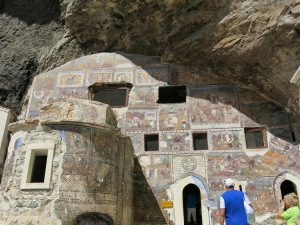
Despite surviving some true pitfalls, arriving at the monastery made the trek worthwhile. The original buildings of the monastery have largely been repaired and restored, thus helping us envision what this monastic village looked like by the 13th century. The Rock Church is built into a cave in the rock face.

Legend has it that the two Greek priests discovered a “miraculous” icon of the Virgin Mary in a cave on this mountain. Supposedly, the icon was made by St. Luke and transported to this site by angels. The two priests decided to build a monastery around the cave — hence the Rock Church — and dedicate it to the Virgin Mary. One additional legend holds that the icon showed a black or dark-skinned Mary, hence the word “mela” in the name, which means “black” in Greek.
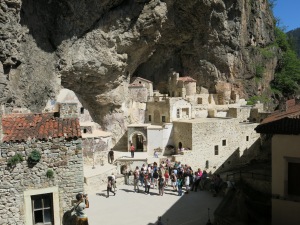
The original icon itself is no longer at Sumela. When a forced “population exchange” took place in 1923 between Greece and the newly formed Turkey, the priests were not allowed to take the icon with them. One enterprising priest buried the icon under the floor of another of the monastery’s chapels before fleeing. In 1930, another priest returned to Sumela and secretly spirited the icon to the “new” Sumela monastery in Greece.
The interior walls and ceiling of the chapel were covered in beautiful frescoes that were created at three separate periods. The earliest of these date to the early 17th c., although archaeologists suspect that there are even earlier frescoes underneath the existing ones. Nevertheless, almost all have sustained damage, many severely so, from anti-Christian vandals and ignorant tourists. My favorite fresco, after the singing angels is one depicting the biblical story of Jonah and the whale:
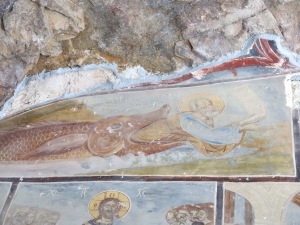
Jonah being swallowed by the whale. Below, another relatively undamaged fresco is of the Madonna and baby Jesus:
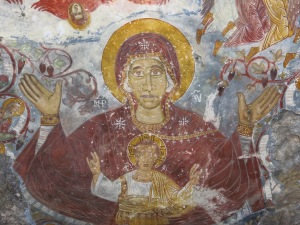
Madonna and Child
Extremely isolated as it was, Sumela Monastery’s inhabitants could not live completely sealed off from the outside world. For starters, the steep, rocky terrain was not conducive to crops. While water aplenty cascaded down the mountains surrounding the enclave, the water didn’t obligingly straight into the wells.
The monks solved both problems by building both an aqueduct to direct the abundant water to them as well as a pulley system that allowed them to haul food and other supplies up the mountain.
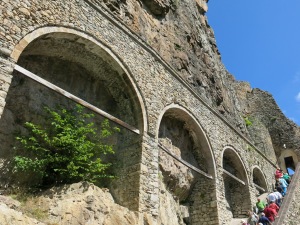
The Sumela aqueduct
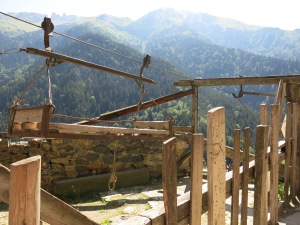
A sled on a pulley allowed the monks to more easily haul supplies up the mountain. Below is a final look at Sumela from the roadway:
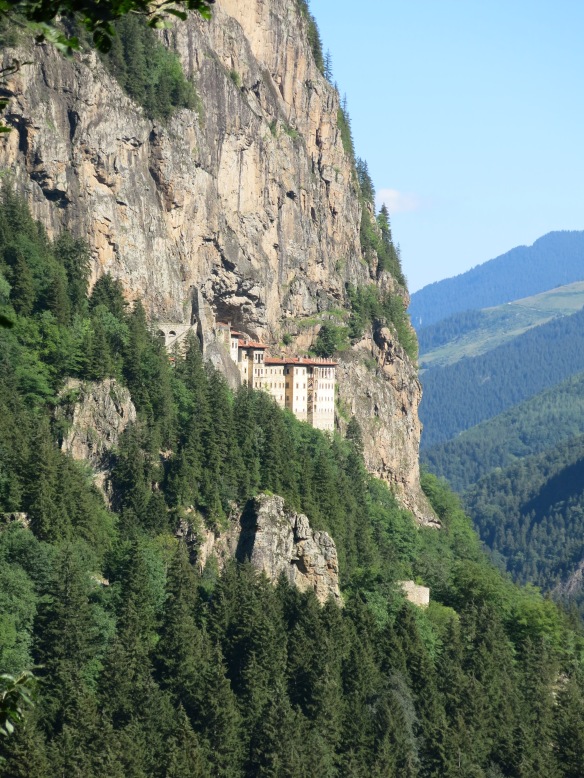
![]()

Carol Barbier Rolnick grew up in Japan and Southeast Asia, traveling extensively as a child through Asia, the Mideast and Europe on family vacations. Travel has continued as a priority through raising kids and continuing into retirement, extending adventures through the Americas, southern Africa, Asia, and repeat trips throughout Europe. Carol and her husband, Michael spent four summers based in Utrecht, The Netherlands, which has become like a second home. They are (still) aiming towards Australia-New Zealand and Antarctica to round off their continental travels.








